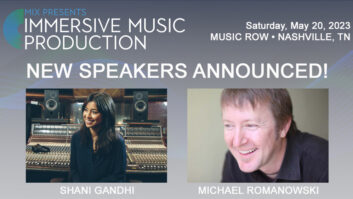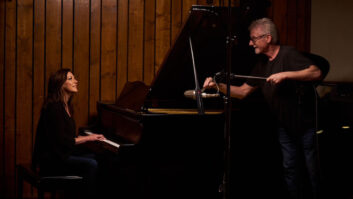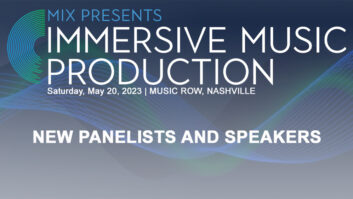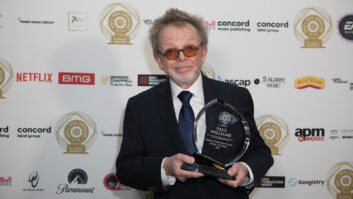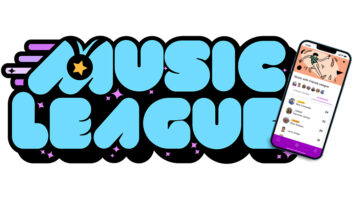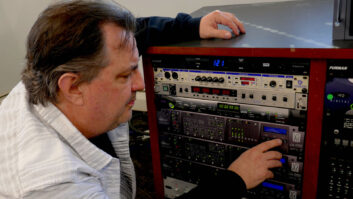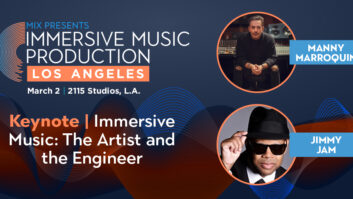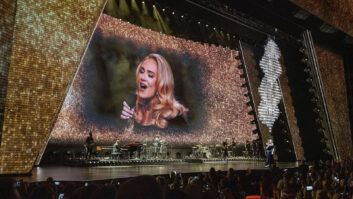
The story so far:
By the end of the 1970s, Frank Zappa had released 28 originalalbums (including seven two-LP releases), either by the Mothers ofInvention or under his own name. Deeply distrustful of large recordcompanies, Zappa had set up his own independent record label and,frustrated by the cost and logistical difficulties of schedulinglockouts in commercial studios, had constructed a state-of-the-artpersonal studio, the Utility Muffin Research Kitchen (UMRK). And toensure the highest-quality live recordings, Zappa purchased the BeachBoys’ remote truck.
The refurbished truck, dubbed the UMRK Mobile, became an integralpart of the touring organization and was used to record every show, aswell as premix various instruments for the FOH and monitor engineers.“I might have 22 channels on the drums,” says Mark Pinske,then working as Zappa’s recording engineer in the truck and at UMRK.“I would take the combination of all of it and send, forinstance, tom toms left and right back out to the house. We might takenine different stereo keyboards, and I would mix them all down to astereo keyboard mix that could go back to the monitors onstage and backto the house mix. We found that we had a lot more control over thefeedback and a lot fewer problems with the recordings, because we hadthe same sonic tone and the same path pretty much going to each of thelocations. I had 85 noise gates in the truck, and we could pretty muchcontrol everything. I could hear problems — little buzzes or hums— and we could isolate the problems, and then I could treat themwith some of the best outboard gear you could get and send it back tothese guys, and it would be all spiced up. And, of course, you’re notgoing to get the kind of equalization that you have in a Neve consoleout of a little portable Midas board.”
With two Ampex MM1200s running at 30 ips, the operation soonrequired bulk shipments of tape to various points on the tour.“On the first three-month tour, we had 946 master tapes, if Iremember correctly,” says Pinske. “A huge amount of masterreels of tape. Normally, it would take about eight reels a show,overlapping them. A lot of times, we did these small theaters inAmerica, so we would do double shows, and Frank had a habit of notrepeating any of the songs from show to show. So we’d have pretty muchdifferent tunes through both shows.”
MAGIC FINGERS
Having played about 825 concerts in the preceding 10 years, Zapparetired from touring in July 1982 and devoted his energies to newstudio recordings and mixing the now-enormous backlog of live tapes.Bob Stone, formerly chief engineer at Larrabee, where he had mixed manyof Casablanca’s disco hits, including Donna Summer’s “LastDance,” joined the UMRK staff in 1980, and he and Pinske wound uptag-teaming on Zappa’s various remix projects. “Frank liked towork around the clock,” recalls Stone, “so we’d takeshifts. I’d leave a setup for mixing on the console and leave any notesthat needed to be done.” In fact, the surprise hit “ValleyGirl” (from the 1982 Ship Arriving Too Late to Save a DrowningWitch album) was mixed while Zappa was asleep. “When he gotup the next morning to check out what happened the night before,”Stone says, “he thought maybe one of the vocal raps might havebeen a little different, from a different track earlier in the tape.But I’d already tried that and knew it wouldn’t work. I demonstratedthat to him, so we went back to what I had and moved on. That was aboutall the attention we gave it.”
“Valley Girl” became Zappa’s highest-charting singleand, along with an out-of-court settlement with Warner Bros., providedfunding for Zappa’s next recording adventure. In January 1983, Zappaand Pinske traveled to London to record the London Symphony Orchestraperforming various “classical” pieces that Zappa hadcomposed since 1968. Unable to secure a good concert hall for therecording date, Zappa wound up recording the 105-piece orchestra on asoundstage at Twickenham Film Studios, using about 40 prototype CrownPZM microphones (supplied by Ken Wahrenbrock) in unusual close-mikingconfigurations. Another technical innovation was the use of Sony’s newPCM-3324 digital recorder, but neither the wide dynamic range of thedigital medium nor the separation achieved through close miking couldentirely save the performances. “I think we had about 1,000edits,” Pinske recalls of the remix sessions. “We werecounting them at one point — we got up to like 900 — and wedecided that counting them was ridiculous. But [Zappa] could edit likenobody could. When I first started with him, I was afraid to pick up arazor blade. Now, I could put a breath into a vocal or take a breathout. I was just privileged to be able to have learned from somebodylike that.”
Despite his dissatisfaction with the LSO’s performances, Zappa wasextremely impressed by the apparently noiseless digital recordingmedium and wound up leasing and eventually owning two Sony PCM-3324s,as well as a Sony PCM1610 for 2-track mixdowns. From 1984 on, all ofhis new recordings, both in the studio and live, were in the digitalmedium.
HE MADE ME DO IT
Back at UMRK, Zappa, Pinske and Stone busied themselves with anarray of recording and remix projects. With various lawsuits finallysettled, Zappa had regained the masters for all of his LPs on theWarners-distributed Bizarre and DiscReet labels, along with theMGM/Verve master tapes of the early M.O.I. albums. Most of theserecords had long been out-of-print, and, as it turned out, several ofthe master tapes were unplayable and required considerable restorationwork before the LPs could be reissued.
Fortunately, a Studer 2-inch 24-track had been included in thepurchase of the Beach Boys’ truck. “That was a lot better24-track, sonically, than the Ampex MM1200s,” says Pinske.“We made homemade guides so I could take the 12-track 1-inchtapes and play them on the bottom 12 tracks of the 24-track 2-inchhead. It was a real meticulous thing: You couldn’t rewind them fast,because the tape would creep up and wouldn’t pack right. And, you couldreally only pass them through one time, because the guide system wasn’tall that great.” Over a three-month period, Pinske managed totransfer all of the various M.O.I. masters to digital and also createddigital-clone safety copies.
The first Old Masters box set of M.O.I. LP reissues came outon Zappa’s Barking Pumpkin record label in April 1985; the seven vinyldiscs included a Mystery Disc of outtakes and archival oddities.Two more nine-LP volumes were released in 1986 and 1987, the first ofthese also including a second Mystery Disc. Some of the albumswere more or less unchanged transfers of the original album masters,but several had been completely remixed and, in some cases, had newbass and drum tracks added.
DRUMS ARE TOO NOISY
As Zappa wrote in his autobiography, “What qualified as an‘acceptable drum sound’ on a 1950s recording seemslaughable today,” and as technology advanced, he expendedconsiderable time and energyongettingbetter-than-acceptable drumsounds, both live and in the studio. One of the benefits of owning theUMRK Mobile was that all road tapes were made on the same equipment andtape format, factors that allowed Zappa considerable latitude inediting among different shows. In order to ensure even moreconsistency, Pinske and drum tech John Goode developed a system topermanently mount microphones in Chad Wackerman’s drum kit. “Wewould try all kinds of different drum heads and all kinds of differentmicrophones to get the absolute best drum sound we could get,”recalls Pinske. “So when we were done, we would have a reallyelaborate, great-sounding drum set. I think the ultimate drum soundthat we ever had was on the Man From Utopia album [1983]. AndFrank started really liking this really good drum sound and kind ofwanted to start hearing it on just about everything. I was kind ofupset about the fact that he wanted to replace the drums [on the olderalbums], because I had already gotten a pretty good drum sound out ofeven the mono recordings that were on the original tapes.”
In some cases, reassembling the original album proved impossible.“I always liked the Fillmore East — June 1971 album,because I laughed at that album a lot,” says Pinske. “ButFrank couldn’t even remember where he got all of the edits from to putthat together; he had edited that thing, silly. So when we tried toreconstruct that album, it was damn near impossible, because hecouldn’t even remember where he got what cut from. So, we’d have tohunt around and say, ‘Jesus, where’s this next section?’And sometimes, we just didn’t find them.”
Another problem with archival tapes was due to the different agingcharacteristics of the two tape stocks used for live recordings.“We cut a deal with Ampex to drop hundreds of rolls of tapes atdifferent cities, like Chicago, New York, wherever,” says Pinske.“Well, Agfa started bidding for the business, and we startedusing Agfa 468. We switched in the middle of the tour, and when we gotoff of the tour, we started razor-blade editing a lot of the songstogether from different shows, and you couldn’t even tell thedifference in the cymbals across the edits. That’s what Frank likedabout the consistency we did in the recording. Well, some of the tapesthat we meant to mix for an album we didn’t get to mix, because weedited way more songs than we were able to have time to mix, so we putthem in the tape vault. When we pulled them out a year later, the editsdidn’t work. The cymbals would drop as much as 3 or 4 dB at the highfrequencies when they went to the Ampex 456, and then when we went backto the Agfa tape, it would get bright again. This was very frustratingfrom an engineering standpoint. When I remixed the whole BabySnakes movie [1983], we would have tapes that maybe the first 20seconds would sound right, and then all of a sudden, it would get dulland everything would change. We’d have to strike the board and reseteverything just to make the edit work. And you might strike the boardmaybe eight, 10, 12 times through one song, just to try to make thesonics match on edits that originally ran across likebutter.”
THAT’S NOT REALLY REGGAE
These problems did not, of course, affect digital recordings. By1984, Zappa not only had an all-digital setup at UMRK, but he had alsostarted working on the Synclavier DMS, an all-digital sampling computerthat allowed him to compose and reproduce music that would stump eventhe most capable human musician. Zappa’s first project with the devicewas an all-Synclavier rendition of chamber music by the obscure18th-century Italian cellist — and possible ancestor —Francesco Zappa. More sophisticated Synclavier tracks showed up onThe Perfect Stranger — Boulez Conducts Zappa, a 1984recording by the Ensemble InterContemporain, and Synclavier tracks andsamples also began to appear in Zappa’s band-based recordings.
At this point, Zappa’s recording universe was complete: He owned astate-of-the-art digital recording facility and the ultimate samplingsynthesizer, both maintained by a skilled technical staff availablearound the clock; he had regained control of his back catalog; and alsohad access to a cadre of superb musicians who could play pretty muchanything he put in front of them. Distribution of Zappa’s recordscontinued to be problematic, but having paid all of the recording costsup front, he was in a position to demand exceptionally profitableroyalty rates. “He would give the record company 15percent,” recalls Pinske. “So Frank ended up making, inthose days, like $2.25 off each record sold. And that was unheard ofcompared to somebody like Dylan, who would make 18 cents a copy. Byhaving that kind of control, he was able to take more money in and nothave to have all Platinum albums. Because he knew his music wasoff-the-wall enough and wouldn’t be played on the radio — that hecouldn’t get that kind of volume — he set up his businessaccordingly. The bulk of his money still came from live performances— he got paid well for performing — and also, he sold aheck of a lot of memorabilia, whatever you could put in the mail:T-shirts, you name it.”
I DON’T KNOW IF I CAN GO THROUGH THIS AGAIN
One segment of Zappa’s business, however, remained stubbornlyunprofitable. Despite the apparent success of his“classical” outings — The Perfect Stranger hadreached Number 7 on the Billboard Classical chart and alsogarnered a Grammy nomination — the costs associated withorchestral performances proved prohibitive. Exasperated by the world of“serious music,” Zappa returned to the road in July of1984. Again, most of the 130 or so shows on the six-month20th-Anniversary World Tour were recorded, this time in the 24-trackdigital format. At the end of the tour, Zappa again announced hisretirement from the road, though he kept several bandmembers busyoverdubbing on various current and archival projects and recordingsample libraries for the Synclavier.
For the next three years, Zappa hunkered down at UMRK. Only one newband-based album appeared during this period — the 1985 FrankZappa Meets the Mother of Prevention — and it seems likelythat Zappa spent much of his time working with the Synclavier. In 1986,he released Jazz From Hell, which, apart from a live guitar solofrom the 1982 tour, was entirely created on the Synclavier; the recordwas nominated for two 1987 Grammys, winning one for Best RockInstrumental Performance.
Zappa was always interested in achieving the best quality possibleon vinyl; for better fidelity, most of his LPs clocked in at less than20 minutes per side, and his past experiences with inferior pressings,unauthorized MGM compilations and bootlegs made him extremely wary ofsending out master tapes. Eventually, he went so far as to preparemetal parts for foreign pressings and would typically cut multiplelacquers for each release.
“I still have a collection of studio lacquers, because Frankhad me pretty much do all of the mastering runs,” says Pinske.“We started doing a lot of mastering over at Capitol, andeventually, we ended up with a guy named John Matousek over atHitsville, Motown. I would run down at two or three o’clock in themorning, we’d run off a lacquer, I’d bring it back up to the studio,and Frank and I would listen to it. Frank would say, ‘Okay, godown and have them take off one-half of a dB at 800 Hz.’ And I’dgo down there, and most of the guys would laugh. One-half dB? Some ofthem didn’t even have one-half-dB increments. But we would do it. AndFrank could hear the difference. I would even put the wrong one on,just to see whether or not he would hear the difference, and he wouldhear it right away.”
THE CHROME-PLATED MEGAPHONE OF DESTINY
By the mid-’80s, it was clear that the CD format would soon overtakeLPs and cassettes. But Zappa, whose distribution arrangements seemed tobe in a constant state of flux, had only two CDs on the market: ThePerfect Stranger on the Angel label and a live album from the 1984tour, Does Humor Belong in Music?, released by EMI in Europeonly. After making a deal with Rykodisc to reissue 24 albums on CD overa three-year period, Zappa again went back to the master tapes.According to Stone, “Frank’s concept was, if there’s a new gadgetthat might improve the sound or make a technical difference, he’d say,‘Well, let’s try it. We’ll just remix it or remaster it with thenew goody.’”
Not all of the new goodies proved useful. “Somebody onceshowed up with a box that was supposed to do somethingwonderful,” recalls Stone. “I’m not sure I can evenremember, or should remember, who it was, but it had a bypass position,which was supposed to be direct. So I set up to A/B from our source andpointed out to him, ‘How come it sounds different in the bypassposition?’ They couldn’t quite explain that one to me, so theywent away.”
There were some hiccups in the CD-reissue program: Rykodiscinadvertently pressed from a wrong or truncated master tape and severalexcellent-sounding European CDs were replaced with obviously inferiorversions. (The two most egregious examples, Tinsel TownRebellion and You Are What You Is, have since beenremastered by UMRK engineer Spencer Chrislu.)
By 1988, Zappa was itching to perform again and put together an11-piece band for a projected six-month tour, Broadway the Hard Way.The tour unexpectedly ground to a halt due to personnel differences,but Zappa was able to salvage three live albums — two of themtwo-CD sets — from the 48-track digital tapes. And, as the tourgot under way, he introduced his biggest project to date: thecareer-spanning You Can’t Do That on Stage Anymore series.
Though superficially straightforward, being nothing more or lessthan a record of Zappa’s various groups in performance captured over a20-year period, the You Can’t Do That on Stage Anymore seriesincorporates a slew of mind-boggling edits and demonstrates a totalmastery of sequencing — no trivial accomplishment in the contextof 12 concert-length CDs. And, for the first few YCDTOSAvolumes, matching ambiences from one track to the next requiredconsiderable skill. “Frank loved to edit things himself, like themultitracks,” says Stone, who is credited with engineeringsupervision for the entire YCDTOSA Series. “So he’d takethe road tape 24-track and do brute-force edits from one show toanother. Now, you can imagine the acoustic and sonic differences from asmall club to an open field, not to mention the difference inperformances. His idea of editing was to edit for musical accuracy. Soit was my job at that point to transform those edits into somethingthat sounded like a natural EQ change. We had some programmableequalizers that I could preprogram for different EQs, and sometimes I’dmake the EQ changes on-the-fly as the thing was going. Some of it wasdone in the mix; some of it was done in the mastering. I ultimately gothim away from editing the multitrack and developed a system where Icould mix and match to an EQ or a venue.”
By the time Zappa and Stone worked their way through to YCDTOSAVolumes 5 and 6 (released in 1992), they were able to useSonic Solutions, which allowed for more or less seamless edits betweenperformances recorded as long as 17 years apart. Zappa also madeextensive use of Sonic Solutions’ ambience-matching capabilities in hisfinal Synclavier masterwork, Civilization Phaze III, whichblended under-the-piano dialogs from the original Lumpy Gravysessions with new characters and conversations recorded two decadeslater.
BEAT THE REAPER
Zappa had been experiencing health problems for some time when, inlate 1989, he discovered that he had advanced prostate cancer. Despitethe rigors of chemotherapy and his steadily declining condition, Zappacontinued to update and tweeze his catalog and, in addition to theYCDTOSA set, managed to prepare for release of at least anothernine CD collections, including five two-CD sets. One of these projectsresulted from a collaboration with the Ensemble Modern, an 18-piececooperative of highly skilled classical musicians who sought Zappa outand demonstrated their commitment to perfecting a complete program ofnew and rearranged Zappa compositions. After extensive and gruelingrehearsals, the finished 90-minute program was presented —through an innovative 6-channel surround P.A. — at the 1992Frankfurt Festival and at other concert venues in Germany and Austria.A concert recording named The Yellow Shark was released onlyweeks before Zappa’s death in December 1993 and reached as high asNumber 2 on Billboard‘s Classical charts.
Zappa’s entire catalog (70 CD releases and counting) is availablefrom Rykodisc and Zappa’s Barking Pumpkin label. Further, the ZappaFamily Trust has recently established the Vaulternative label as aconduit for further releases from the massive archives. Of course, thesheer volume of Zappa’s output makes it difficult for all but the mostdetermined (or obsessive) listeners to digest and appreciate hiswide-ranging oeuvre. But, as implied at the beginning of thisarticle, even those Mix readers who are indifferent to Zappa’smusic cannot fail to be impressed by his technical expertise and doggedpursuit of sonic excellence. Even hardcore Zappa fans would admit thatnot every release is essential, but, as with any serious artist,unfinished sketches and imperfect realizations often illuminate themain body of work. Anyone with an interest in the recent tumultuoushistory of recording technology, a curious mind, tolerant housematesand enough time to spare should attempt to climb this Mount Everest ofthe critical-listening landscape.
UMRK REDUX
Though Frank Zappa’s personal studio, Utility Muffin ResearchKitchen, was a state-of-the-art facility throughout the 1980s, it wasmore or less mothballed after Zappa’s death. However, in 2002, theZappa Family Trust decided to finance a complete refurbishment,including architectural changes.
“For the last eight years, nothing has been done in thatroom,” explains Dweezil Zappa, himself an accomplished musician.“The last major change to the studio was to accommodate thechange of console from the Harrison to a Neve VR 62; that was in about1990.” In fact, Dweezil tried using the studio during the 1990sbut, unhappy with the sound of the control room, instead built aproject studio in the vocal booth. “I had done some projects withthat Neve, and there were always some things that seemedquestionable,” recalls Dweezil. “I have some old Nevemodules — 1073s and 1272s — and I like the old stuff. Butfor some reason, anything I did with that console and in the old roomdidn’t work out, so I didn’t feel confident with it. The monitoringwere these giant JBL speakers, and I thought the room sounded a bitstrange.”
The impetus to update the control room came from the Zappa family’sdecision to continue releasing archival material on the recently formedVaulternative label. (The first release, a two-CD volume that documentsa 1976 live show in Sydney, Australia, became available in summer2002.) “Our hands have been tied while the studio has beennonoperational,” explains Dweezil. “It’s only now thatwe’re going to be able to pick up the pace and deliver things thatpeople have been asking for and also discover things we didn’t knowexisted.” One much-anticipated release will likely be a selectionof live recordings by the so-called Petit Wazoo band, a 10-piece M.O.I.that played a score of dates in late 1972.
The acoustic redesign of the UMRK control room, a collaborativeeffort between Dweezil and Zappa’s wife Gail and Art Kelm, features afull 5.1 monitoring setup. Though only a couple of Frank Zappa’smid-’70s records were mixed in the quadraphonic format, the composerspecified a six-point surround P.A. system for the 1991 YellowShark concerts and would undoubtedly have remixed much of hiscatalog for surround had he lived. “We recently did a 5.1 projectwith one of the concerts from 1978 in New York at the Palladium,”notes Dweezil. “It was originally recorded by Joe Chicarelli, andwe got in touch with him to do the 5.1 mix on it: We thought it wouldbe fun for him to revisit the material all these years later. So thatrelease effectively recreates the concert and adds so much depth to themusic. 5.1 is a different format that works really well, I think, forFrank’s music, because there are so many textures involved and they’reconstantly changing. It’s not necessarily the best format for all typesof pop music, but it works for people whose music stands the test ofrepeat listening.” The 5.1 Palladium remixes in DTS are scheduledfor a January 2003 release on Vaulternative.
To properly accommodate a 5.1 surround-monitoring system, thecontrol room was expanded in the rear and a new machine room was addedto house two digital Sony 3324s and various analog tape machines.“The ceiling is now much higher, and it’s a more open-soundingroom,” notes Dweezil.
Another major change is that the analog Neve VR 60 has been replacedwith a digital Sony DMX-R100. “I had been working with the Sonyand found it to be a much better tool for me,” says Dweezil. Newor remixed recordings will be stored in either a Euphonix R1 hard diskrecorder or workstation-based Steinberg Nuendo. “The Synclavierwe’re keeping because there are probably over 2,000 compositions in itin various stages of completion,” adds Dweezil. “Eventhough it’s an archaic setup, there’s nothing else we can use to getthose things out. Ultimately, over time, we’re planning on making asound effects library out of the samples that Frank made and trimmedhimself.”
Though some of the original studio equipment has gone missing— Dweezil especially regrets losing track of the Pultecequalizers — the vintage mic collection is still choice.“There’s a nice collection of Neumanns: some M49s, some M50s,some U47s. I believe there’s one Telefunken U47,” notesDweezil.
Staffing the newly revived facility will likely be on an as-neededbasis. “I’m going to be the main engineer on my projects, and ifthere are other things that we decide to bring in, we will hire someother people we enjoy working with,” says Dweezil.“Vaultmeister” Joe Travers, whose full-time job is toidentify the many hundreds of tapes in the vault, will no doubt beinvolved in some of the archiving. “As it relates to projects ofFrank’s, it’ll most likely be the two of us,” says Dweezil.“I’ve also talked to other engineers, like Bob Clearmountain, andI’d like to get some other engineers’ takes on Frank’s music. I hope todo some high-end 5.1 or detailed audiophile special projects thatinvolve great mixers. We’re also working on putting together some DVDsand finishing the Roxy and Elsewhere movie that Frank started tomake. There’s all kinds of stuff in the vaults that Frank did on2-track or in apartments. There’s easily another 30 years of releases— it’s that crazy.”
— Chris Michie

UncleMeat MP3 – Released in 1969, Uncle Meat was partlyrecorded on a prototype 12-track machine and features many complexarrangements created by extensive overdubbing. This short excerpt istypical of the new sound palette that Zappa was coaxing from the newlyaugmented M.O.I.
Zappa’sOwn Words… 20 Years Ago – Read an excerpt from a Mixinterview with Frank Zappa originally published in June 1983.
The Complete Mark Pinski Interview – While researching hisFrank Zappa retrospective, Mix technical editor Chris Michie spent along time talking with Zappa’s longtime studio and road engineer,Mark Pinske, getting a wealth of valuable material over three days ofinterviews. Read the conversations in their entirety here:
Pinski Interview Day One, Two, Three
